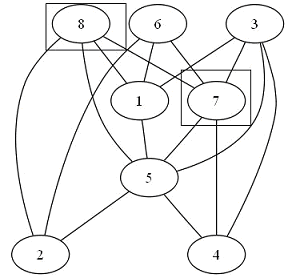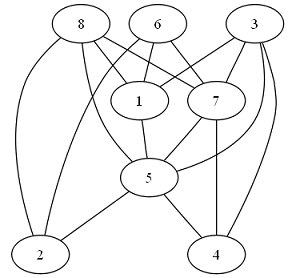Connected Dominating Set
Problem description
A connected dominating set in an undirected graph G=(V,E), where V is a set of vertices, and E is a set of edges, is a subset D of vertices in the graph such that the following two conditions hold:
- for every vertex v in V: either v is in D, or there is a vertex u in D such that uv is an edge of G
- the subgraph induced by the vertices in D is connected
Input format
Input graphs are stored in plain text files, one file for each graph. The format of the file is as follows:
- The file starts with lines that define vertices. Vertices are defined using predicate name "vtx". Vertices are represented as integers that start from 1 and end at n, where n is the number of the vertices.
- The definition of edges follows. The predicate name used to define edges is "edge". Predicate edge has two parameters. Intuitively, edge(x, y) means there is an undirected edge between vertex x and vertex y (we assume no loops).
- The predicate name that provides the bound k on the number of vertices in the dominating set is “bound”.
- Every line ends with "."
Output format
The programmers must ensure that, in the answer-sets, predicate "dom" is used to represent the dominating set found by their solvers. Predicate dom takes one parameter: dom(x), which means that the vertex x is in the connected dominating set of size at most the specified bound.
Example
Input:
vtx(1). vtx(2). vtx(3). vtx(4). vtx(5). vtx(6). vtx(7). vtx(8). edge(8,5). edge(7,4). edge(8,7). edge(7,5). edge(6,7). edge(8,1). edge(3,4). edge(6,1). edge(6,2). edge(3,5). edge(1,5). edge(5,4). edge(3,7). edge(5,2). edge(2,8). edge(3,1). edge(7,1). edge(6,4). edge(4,2). edge(8,4). bound(3).
Graphical representation of the given graph:
Valid Output:
dom(7). dom(8).
The vertices in the dominating set is shown within the rectangle:

Authors: Gayathri Namasivayam and Miroslaw Truszczynski
Affiliation: University of Kentucky
